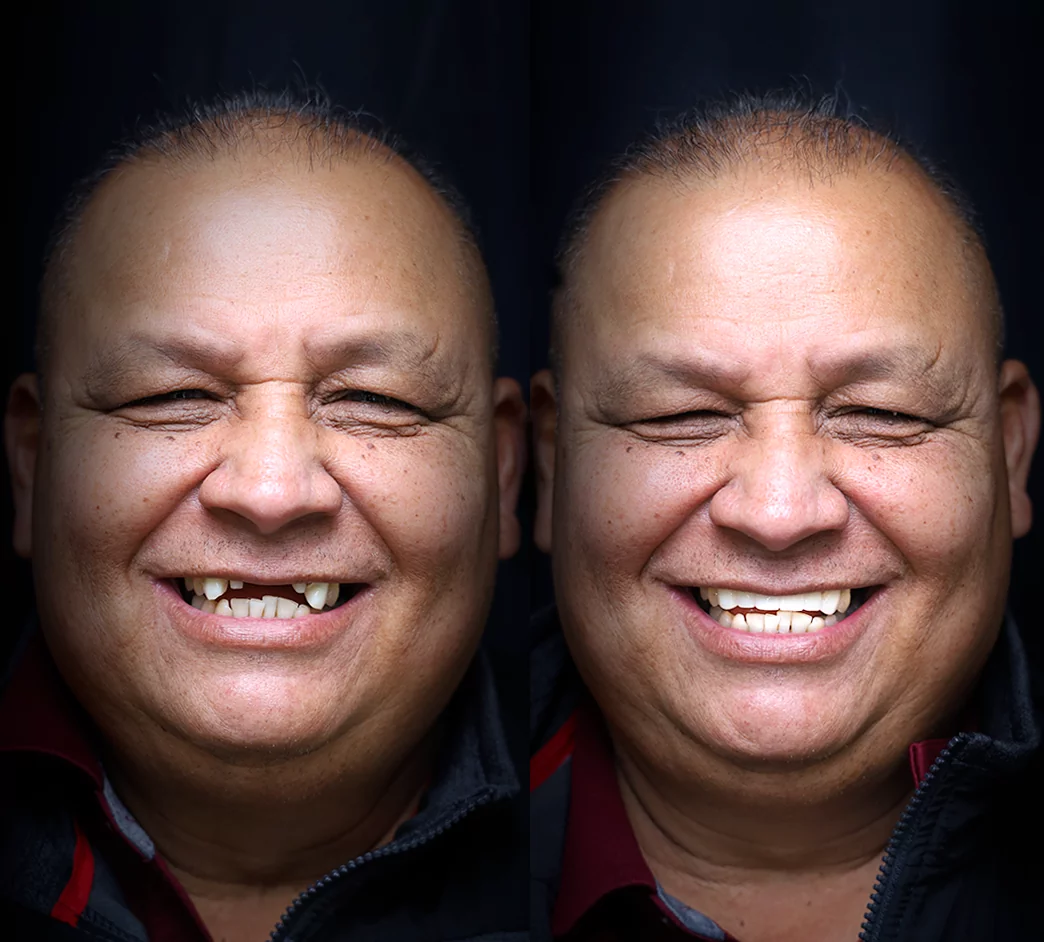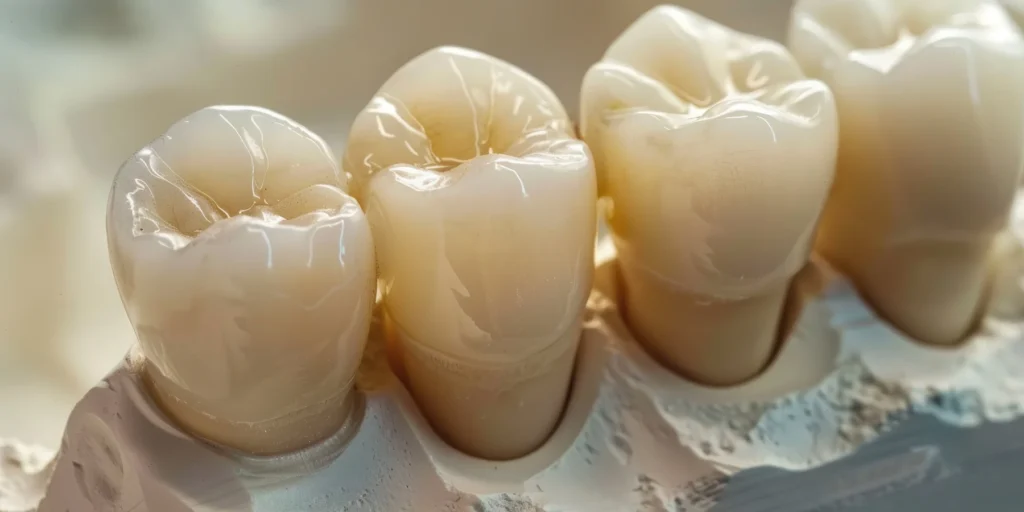Dental Bridges in Los Algodones, Mexico
A fixed, natural-looking way to close gaps and restore your bite.
Dental bridges in Los Algodones replace one or more missing teeth with a custom, secure solution that blends with your smile.
Expect digital impressions, precise shade matching, and clear, written pricing before any work begins.
Starting at :
$597 USD / for a 3 unit bridge

What Are Dental Bridges?
A dental bridge is a fixed restoration that fills the space left by missing teeth. It anchors to the neighboring teeth or dental implants and carries a replacement tooth called a pontic. Because it is cemented in place, you do not remove it for daily use.
Most patients receive a traditional bridge, which is supported by the teeth on each side of the gap. Other options include cantilever bridges when there is a single abutment tooth, Maryland bridges that use small wings bonded to the back of adjacent teeth, and implant-supported bridges for longer spans. Materials range from porcelain fused to metal to full zirconia and layered ceramics for strength and lifelike translucency.
Dental Bridges Before & After In Los Algodones, Mexico
See Why Our Patients Choose Us:





Benefits of Dental Bridges
A well-made bridge brings back chewing power, speech clarity, and the natural contours of your smile. It also helps keep neighboring teeth from drifting into empty spaces, which can throw off your bite.

Stable chewing and clear speech
Fixed in place, so it does not come in and out like a denture.

Natural look that blends in
Shade and shape matched to nearby teeth for a seamless result.

Fast, predictable timeline
Often completed in a few short visits with a comfortable temporary.

Easy daily care
Brush normally and clean under the pontic with floss threaders or interdental tools.
Cost of Dental Bridges in Los Algodones
Your price depends on how many teeth the bridge replaces, the material you choose, and the health of the supporting teeth.
Some cases include extra steps such as core buildups, root canals, or gum therapy to create a strong foundation. If implants support the bridge, components are itemized separately. You will receive a written treatment plan with line items and timelines, so you can compare options and choose what fits your goals and budget.
3-Unit bridge
PFM

From
$597 USD
3-Unit bridge
Full Porcelain

From
$1,050 USD
3-Unit bridge
Zirconia

From
$1,350 USD
Start Your Plan
Ready to fill the gap with a fixed, natural-looking solution? Cross the border, visit the clinic within minutes, and leave with a personalized estimate and timeline.
Why choose Dental Algodones
Experienced restorative team with digital precision

Expertise you can trust
You are treated by dentists skilled in cosmetic and functional bridgework. We guide you through each step with clear, bilingual communication and photos that help you visualize the outcome.

Technology that improves the fit
Digital impressions, precise bite analysis, and aesthetic mockups help us fine-tune comfort and appearance before final cementation. Fewer surprises. Better control.

Quality materials and solid support
We use premium ceramics and partner labs known for accuracy and shade consistency. You get documented materials, transparent warranties, and follow-ups for bite checks and maintenance.
1000 +
Happy Patients
3000 +
Implants Placed
12+
Years of experience
“Everything went smooth I loved it. I should've never waited so long.”
Find out what the most important people, our patients, think of our services.
Why choose Los Algodones for Dental Bridges

Border convenience
Walk from the port of entry or use the shuttle for easy visits.

Excellent value
Competitive pricing with modern materials and careful planning.

Dental-tourism ready
Flexible scheduling, nearby lodging, and clear itineraries for short stays.
How Dental Bridges are made and fitted?
Dental bridges are completed in a straightforward series of visits that focus on accuracy, comfort, and aesthetics.
01 Consultation and records
Exam, photos, digital impressions, bite analysis, and shade selection.
02 Tooth preparation and temporaries
We conservatively shape the abutment teeth as needed and place a comfortable temporary bridge to protect your smile.
03 Lab fabrication
Your custom bridge is crafted to match color and contour for a natural look.
04 Final placement
Try-in, bite adjustments, and permanent cementation once everything feels right.
Ready To Begin?
Here’s the thing: closing a gap does more than improve your smile. It protects your bite for the long run. Start with a quick visit near the border and a plan tailored to your timeline.

Dental Bridges: Pre-op Instructions
A little preparation helps long visits feel easier and keeps your new bridge on track.
Tell us about conditions, allergies, and all prescriptions or supplements. We may coordinate with your physician if you take blood thinners or manage chronic conditions.
For standard numbing, eat a light meal 1–2 hours before your appointment and stay hydrated. If oral sedation is planned, follow fasting instructions and arrange a companion for the trip home.
Brush and floss before your visit. Wear comfortable clothing and avoid strong fragrances. Bring headphones if you like music during treatment.
Some visits can run 60–120 minutes. Plan your border crossing and shuttle timing so you are not rushed.
Take any prescribed pre-visit medications as directed. Bring your list of current meds and any night guard you use for clenching or grinding.
Dental Bridges: Post-op Instructions
Most people feel only mild tenderness after tooth preparation or cementation. Good home care keeps you comfortable while your bite settles.
Expect mild temperature or pressure sensitivity for a few days. Use recommended pain relief as needed and chew on the other side until tenderness settles.
If you leave with a temporary, avoid very sticky or hard foods. Do not floss up and out between the temporary teeth; slide floss out sideways to prevent dislodging.
After final placement, brush normally. Clean under the pontic with floss threaders, superfloss, or an interdental brush once daily. This protects your gums and the margins.
Cut hard foods into smaller pieces. Skip chewing ice and opening packages with your teeth. If you clench or grind at night, wear your guard.
Reach out if pain worsens after day three, your bite feels high, the temporary loosens, or you notice gum swelling that does not improve.
Related Treatments
Bridges often work alongside other services to support function, protect teeth, and improve aesthetics.

Dental Crowns
Crowns are protective caps that cover damaged or heavily filled teeth. They restore strength, shape, and color, and they are commonly used on the abutment teeth that support a bridge. With modern ceramics, crowns look natural and help distribute chewing forces evenly. When abutment teeth are strong and well-crowned, your bridge lasts longer and feels more stable.
From:
$199 USD
Dental Implants
Implants are small posts that replace tooth roots and can support a bridge without relying on neighboring teeth. They are ideal for longer spans or when abutment teeth are not strong enough. Implant-supported bridges help preserve bone and often reduce the need for future dental work on adjacent teeth. Travel timelines differ because implants need healing before restoration.
From:
$750 USD


Root Canal Therapy
If an abutment tooth has deep decay or nerve inflammation, a root canal can relieve pain and keep the tooth as a stable support. The tooth is then rebuilt with a post and core and covered with a crown. This sequence creates a strong foundation for your bridge and reduces the risk of future sensitivity.
From:
$220 USD
FAQs
How long do dental bridges last?
With daily cleaning and regular checkups, bridges often last 7–10 years or more. Longevity depends on the health of the supporting teeth and gums, your bite forces, and habits like clenching. Using a night guard if you grind and keeping the area under the pontic clean can significantly extend the life of your bridge.
Is getting a bridge painful?
You will be numb during tooth preparation and cementation, so you should not feel pain. Mild tenderness or temperature sensitivity is common for a few days as your teeth adjust. Over-the-counter pain relief and avoiding very hot or cold foods usually manage symptoms well. Call us if discomfort increases or persists.
Bridge or implant: which is better for me?
Both restore chewing and appearance. A bridge is faster and does not require surgery, but it uses neighboring teeth as supports. An implant preserves adjacent teeth and bone but needs healing time and may involve additional steps. We will review your X-rays, bone levels, goals, and travel schedule to recommend the best path.
How do I clean under a bridge?
Brush twice daily as usual. Once a day, use floss threaders, superfloss, or an interdental brush to clean under the pontic and along the margins. A water flosser can help but does not replace floss. Consistent cleaning prevents gum inflammation and decay at the edges of the crowns.
How many visits will I need, and how long does it take?
Most cases take two to three visits: records, preparation with a temporary bridge, and final cementation. Complex cases may require an extra try-in to perfect shade or fit. We plan visits around your border timing and can coordinate the lab to keep stays efficient.
Will my bridge look natural?
Yes. We select shade and translucency to match nearby teeth and shape the contours for smooth transitions. Digital impressions and photos help the lab craft a lifelike result. If you want a whiter smile, we can discuss whitening or upgrading adjacent restorations before we finalize the bridge so everything blends.
